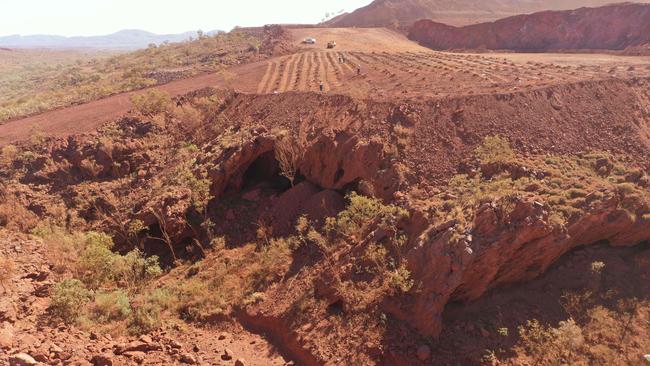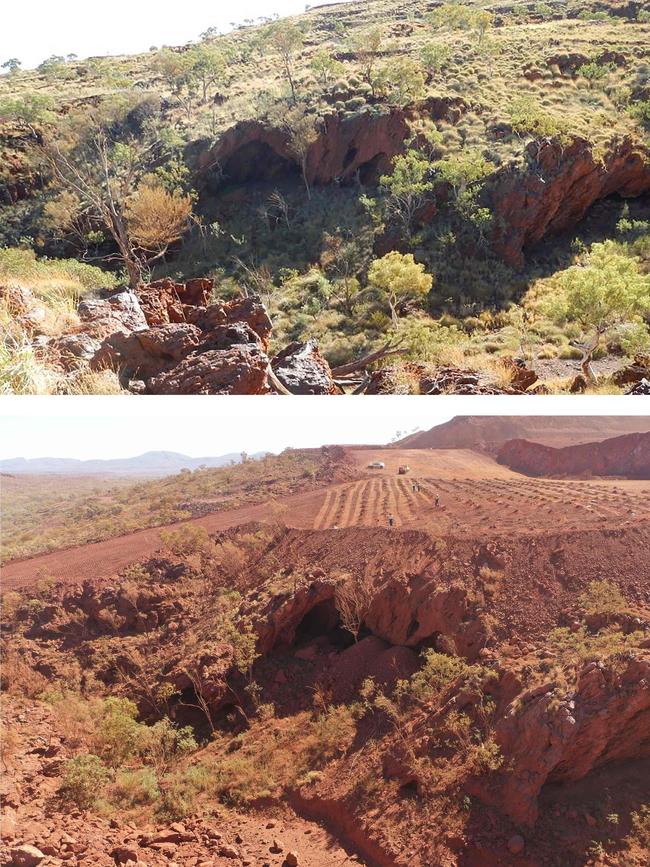Heritage rethink as Rio Tinto blasts Pilbara ruin caves
The destruction of Pilbara caves with a 46,000-year history of human habitation has intensified calls for heritage reform.

An Aboriginal group that only discovered important Pilbara archeological sites had been detonated when it planned to visit says the company Rio Tinto has been embarrassed by public outrage and inaccurate in defending its action.
Puutu Kunti Kurrama and Pinikura Aboriginal Corporation spokesperson Burchell Hayes says Rio Tinto is wrong to claim that the corporation had not relayed the significance of rock shelters within Rio’s Brockman mine site at Juukan Gorge “or our preference that they be preserved.”
“PKKPAC has, on numerous occasions since 2013, communicated to Rio Tinto the significance of Juukan Gorge, in particular the rock shelters in the area.”
He says the information was made clear in an independent ethnographic report in 2013, a report by Scarp Archaeology in 2015 and a documentary “funded and currently in possession of Rio Tinto” in 2015, in which Traditional Owners were interviewed at the gorge about its significance.
“At all times the PKKPAC has been direct and explicit in the archaeological and ethnographic significance of these rock shelters and the importance that they be preserved. For Rio Tinto to suggest otherwise is incorrect.“
The destruction of Pilbara caves with a 46,000-year history of human habitation has intensified calls for reform of the West Australian Aboriginal Heritage Act, including by the state’s Heritage Minister.
Blasting by mining company Rio Tinto took place near the Juukan Gorge on its Brockman mine, 60km northwest of the remote Pilbara mining town of Tom Price, and led to the collapse of ancient rock shelters.
The company confirmed on Tuesday, when the Puutu Kunti Kurrama and Pinikura traditional owners sought access for a visit to the site, that the rock shelters had been destroyed on Sunday.
Rio Tinto said it was acting on permission obtained in 2013 under the state’s heritage provisions to mine the area.
The Australian Archaeological Association says early evidence of human life at Juukan Gorge goes back 46,000 years, putting the site in the oldest bracket for human occupation of Australia’s deserts.
Association president Tiina Manne said destroying the rock shelters occurred in spite of “new and compelling evidence from archaeological excavations conducted after the permit to destroy was issued.”
Any new evidence on a significant site “should be able to be incorporated into agreements with communities and reflected in the level of protection afforded by heritage law”, Dr Manne said.
“The fact that Rio did not revisit this decision after the site’s increased cultural significance was demonstrated by subsequent archaeological excavations, and visits by traditional owners, is inconsistent with modern standards of heritage management. ’’

WA Heritage Minister Ben Wyatt said once permission had been granted, there was “no capacity to reconsider”.
“If new sites are found, you can apply to have them registered but it doesn’t appear as if any of that has happened along the way,” Mr Wyatt said.
“Almost monthly, we are informed of new sites of significance around the state and the current act is a blunt instrument in how we can handle them.”
The minister said it demonstrated the inadequacy of the current Heritage Act, which is being redrafted after nearly 50 years.
Mr Wyatt said he hoped the new act, which would “prioritise the concerns of traditional owners”, would be law by year’s end.
Rio Tinto was legally permitted to destroy the sites under a section 18 notice issued in 2013, a section Mr Wyatt says will be removed in future legislation.
Rio Tinto iron ore chief executive Chris Salisbury said the recent activity followed extensive heritage preservation and salvage work conducted in 2014.
“With the approval of the PKKP, the preserved artefacts have been deposited at a Rio Tinto storage facility to ensure appropriate protection of the material and we are working with the PKKP on longer-term options,” he said.
Mr Salisbury said a site visit to the Brockman operations was made with PKKP representatives last year, and “we are sorry that the recently expressed concerns of the PKKP did not arise through the engagements that have taken place over many years”.
Mr Wyatt said the incident may prompt Rio Tinto to “revisit its procedures to ensure old approvals are reconsidered with traditional owners.”



To join the conversation, please log in. Don't have an account? Register
Join the conversation, you are commenting as Logout